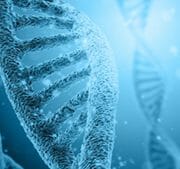NEW MUTATIONS
4 new genetic mutations were recently found:
LOX : This gene of the 5-Lysyl oxidase family is involved in initiating of cross-linking of Elastin and Collagen. The mutation leads to cardiovascular, respiratory and bone symptoms, especially fractures. This is why it was initially considered to be a new type of osteogenesis imperfecta (glass bones disorder). But the discovery of fragmented elastic fibers allowed this mutation to be included in Cutis Laxa Syndroms. It is a recessive form.
EFEMP1 (Fibulin3): The consequences, besides lax skin, of this mutation are multiple hernias and joint hypermobility as well as mild intellectual/learning disability. It is a new recessive type of Cutis Laxa.
LTBP1 : This mutation is distinguished by lax skin, inguinal hernias, craniofacial dysmorphology, various heart defects and prominent skeletal features (short stature, brachydactyly, craniosynostosis,..). It is another new recessive type of Cutis Laxa.
PI4K2A : This 4th new mutation is characterised by the following clinical signs : lax skin, involuntary movements (neurological issue), dysmorphism and intellectual/learning disability. It is also a recessive type.
A 5th new mutation has recently been found and we are longing for it to be published so we can tell you about it.
Thanks to all the researchers for their amazing work in basic knowledge of Cutis Laxa. All these findings are essential to give patients better care and offer them a better quality of life.



